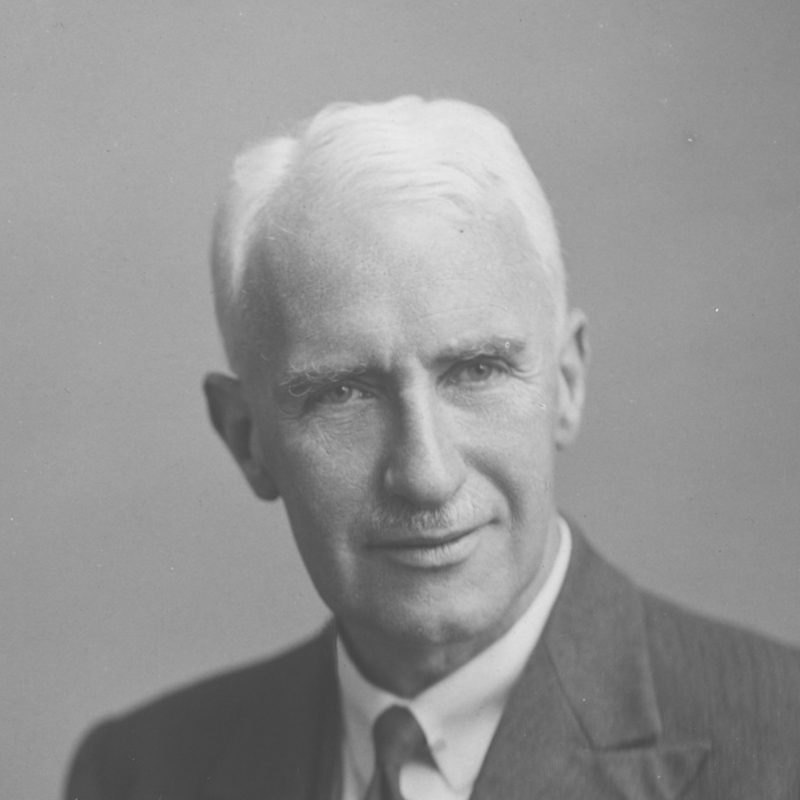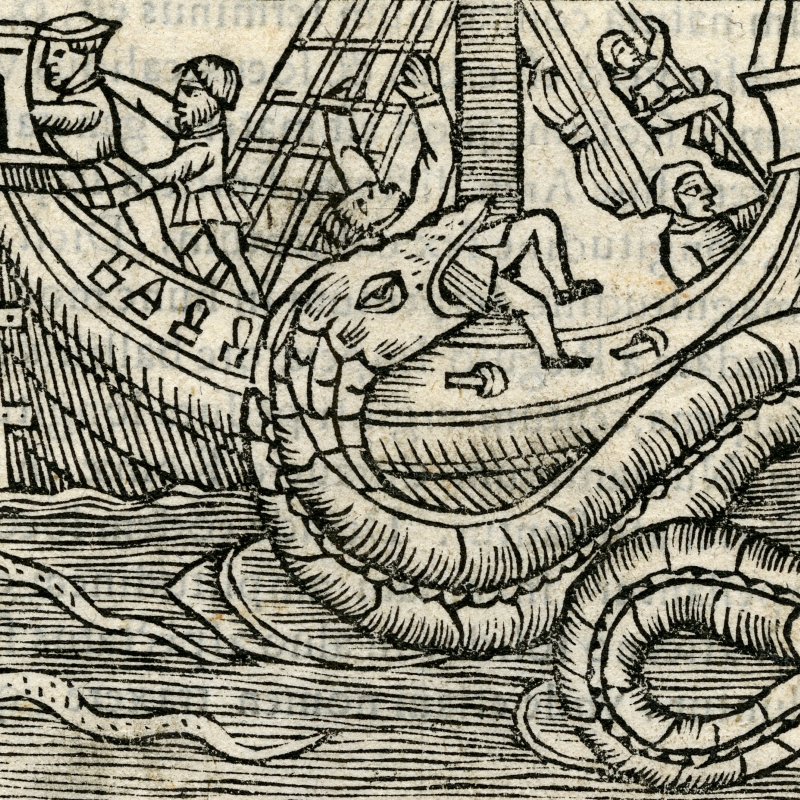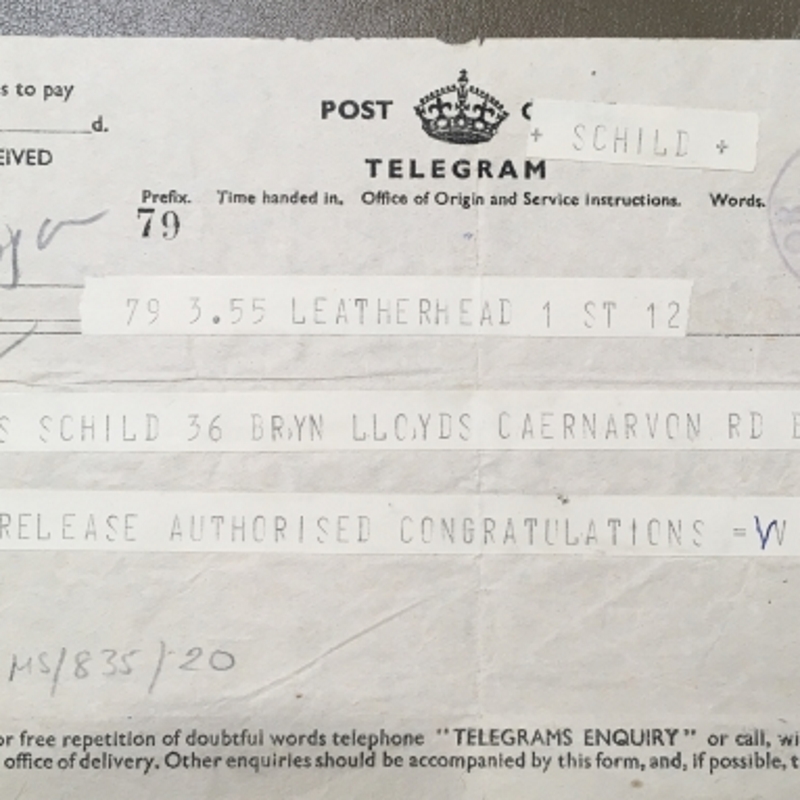In the first half of a two-part article, Royal Society Lisa Jardine Grant recipient Kathryn Maxson Jones describes the impact of squid giant axons on the history of neuroscience using the Society’s collections.
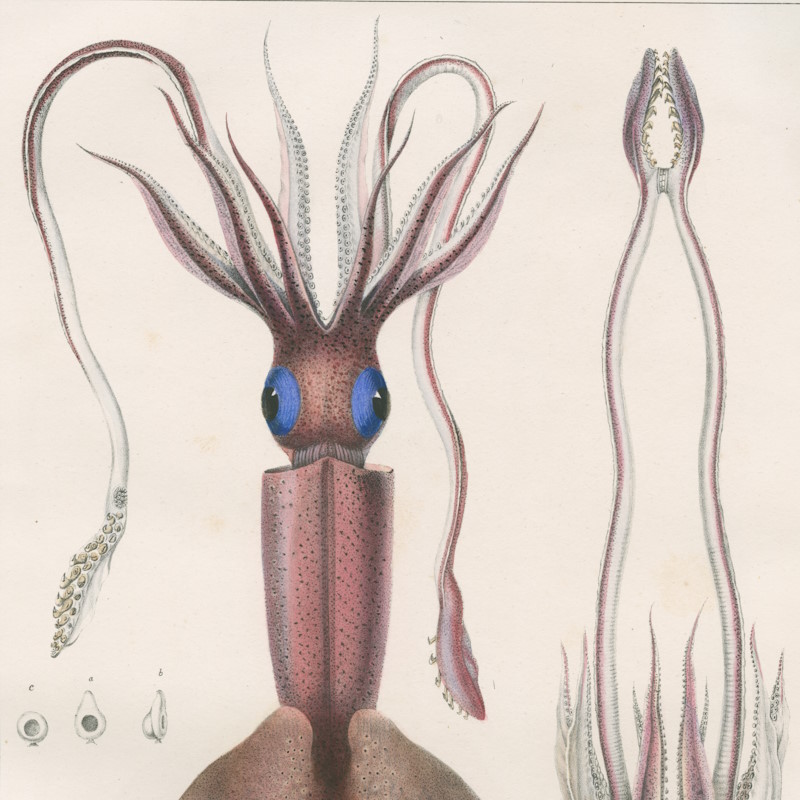
In September 1935, David Keynes Hill FRS (1915–2002), son of the physiologist Archibald Vivian (A V) Hill FRS (1886–1977), captured an informal colour portrait of his father alongside another biologist nearly three decades his junior. Hill and Alan Lloyd Hodgkin FRS (1914–1998) were seated in the garden of the Hill family’s South Devon vacation home, Three Corners, deep in conversation.
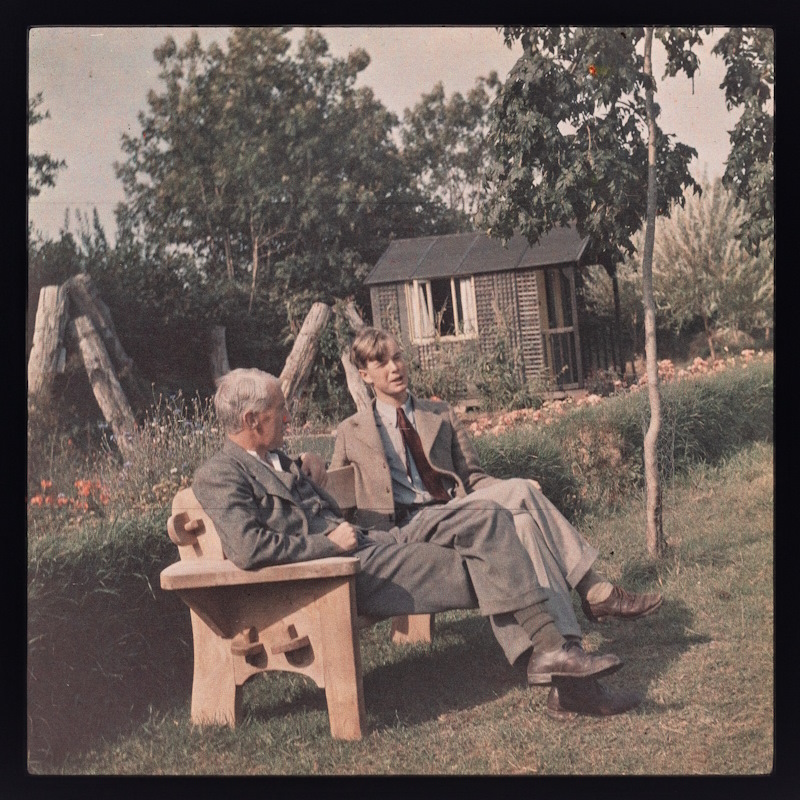 A V Hill (left) and Alan Lloyd Hodgkin (right) at Three Corners, 1935. Photo credit: David K Hill. Image reproduced with the permission of the family of David Hill (IM/001639)
A V Hill (left) and Alan Lloyd Hodgkin (right) at Three Corners, 1935. Photo credit: David K Hill. Image reproduced with the permission of the family of David Hill (IM/001639)
Thirteen years earlier, Hill had shared the 1922 Nobel Prize in Physiology or Medicine with Otto Meyerhof ForMemRS (1884-1951). This had primarily recognised Hill’s work in muscle contraction, but he had also published extensively on nervous excitation, the generation of electrical activity in nerves. In 1926, he became a Royal Society Foulerton Research Professor at University College, London. By 1935, when the photograph was taken, Hill was a world-renowned pioneer in studying the physical and chemical aspects of biological functions.
It was in the field of nervous excitation that Alan Hodgkin, then a recent graduate of Trinity College, Cambridge, hoped to make his career. Hill had invited Hodgkin to Three Corners to do experiments at the nearby Laboratory of the Marine Biological Association (MBA) in Plymouth, founded in 1888. Many marine invertebrates, such as crabs, offered especially convenient material for experimental investigation after tissue dissection, owing to the large sizes of their nerve and muscle cells.
While conducting historical research at the Library and Archives of the Royal Society in July 2024, supported by a Lisa Jardine Grant, the photograph of Hodgkin and Hill was the first item I requested. In a letter accompanying the portrait, A V Hill wrote: ‘This is a present to the R.S. from DK [David Keynes Hill] and me. It is of historic interest in that Alan was 21½ and I was 49. I became Secretary [of the Royal Society] in Dec 1935, Alan President in 1970’. Hill elaborated: ‘Alan lived with us there [at Three Corners] for a fortnight 7–21 Sept 1935 & worked in the Plymouth Laboratory’.
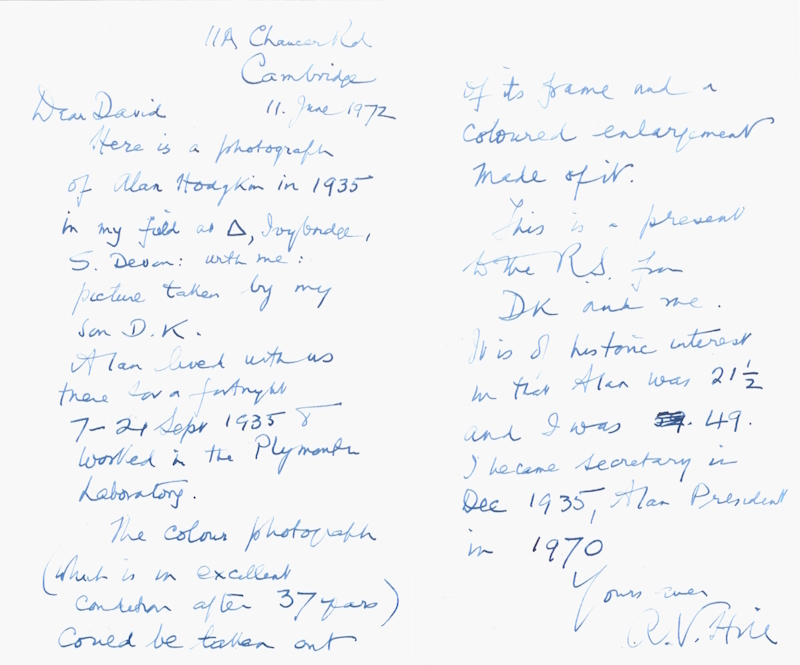 Letter from A V Hill donating the 1935 portrait of him and Alan Hodgkin to the Royal Society, 11 June 1972.
Letter from A V Hill donating the 1935 portrait of him and Alan Hodgkin to the Royal Society, 11 June 1972.
The colour image offers a striking window on biology between WWI and WWII, particularly the indelible links between British biology, research establishments such as Plymouth, and the sea. UCL and Cambridge, where Hill and Hodgkin had their primary posts, predominated, and the importance of mentorship and social connections for promoting the careers of young researchers is evident. The photo says something by way of absences, too: with important exceptions, neurobiology was male-dominated in 1935, even though marine stations often promoted the work of women.
The benefits of historical hindsight allow one to perceive the future in this portrait, as well as the past. In 1935, the incorporation of physico-chemical methods and concepts into biology was becoming increasingly common, promoted by leaders such as Hill. ‘Biophysics’ entered the parlance of life scientists in earnest in the interwar years; by the 1960s, to a not inconsiderable degree through Alan Hodgkin’s influence, it would grow into a fully-fledged academic field.
David Hill would follow his father into physiology and even study with Hodgkin in the 1940s. I can imagine him approaching the two men in the garden, camera in hand, listening in on their conversation while preserving this moment.
At present, I’m hard at work finishing a book, Sea Change: The Squid Giant Axon and the Transformation of Neurobiology in the 20th Century. In it, I explore the intertwined histories of aquatic organisms, seaside laboratories like Plymouth, and biophysical and biochemical studies of the fundamental properties of nervous systems.
Alan Hodgkin is central to this story. His research on squid from the 1940s through the 1960s helped to unravel the electrochemical events that underlie excitation in all nerve cells. Hodgkin would spend his career at Cambridge and its Physiological Laboratory, making frequent trips to Plymouth until 1970. He became a Fellow of the Royal Society in 1948, Foulerton Professor of the Royal Society in 1951 (until 1969), and later President (1970-1975).
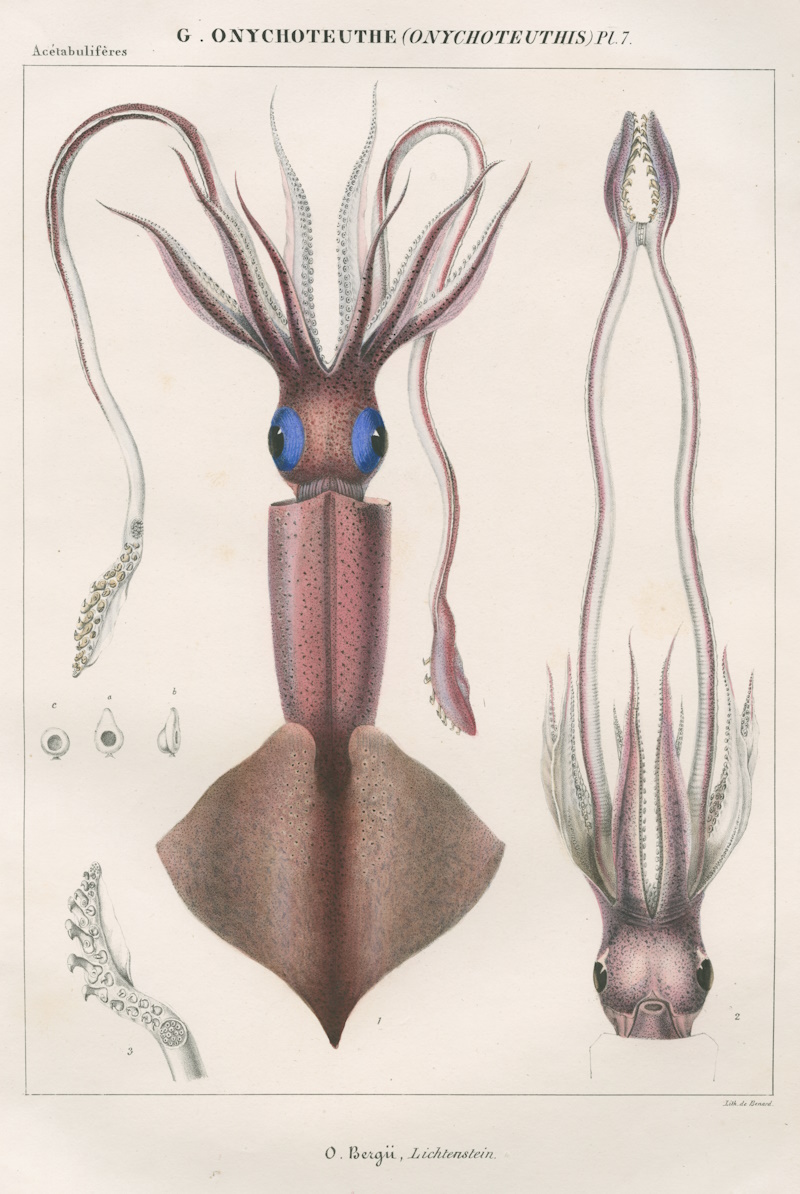 Onychoteuthe bergii (clubhook squid), 1848 RS.9937
Onychoteuthe bergii (clubhook squid), 1848 RS.9937
Squid are marine invertebrates with large brains and acute senses. In the mid-1930s, physiologists learned that squid possess several classes of large axons: fibres from nerve cells (neurons) along which electrical impulses are transmitted. Beginning in 1939, Hodgkin, his former undergraduate student Andrew Fielding Huxley FRS (1917-2012) and A V Hill’s former graduate student Bernard Katz FRS (1911-2003) were able to maneuver electrodes inside these ‘squid giant axons’, enabling direct measurement and (eventually) control of the electrical events that take place in an axon’s membrane during excitation.
Based largely at Plymouth, these experiments allowed Hodgkin, Huxley and Katz to postulate how electrical activity in squid axons arises from the movements of ions, namely positively charged sodium and potassium. Hodgkin and Huxley shared two-thirds of the 1963 Nobel Prize in Physiology or Medicine for this work, with the other third going to John Carew Eccles FRS (1903-1997).
In Sea Change, I ask: how did the squid giant axon impact neurobiology writ large, from investigations in the 1930s to the new millennium? This question begs another: how did those who studied this unusual structure come to believe that its properties represented general principles? How well did the squid giant axon represent what happens in a cat nerve, for instance, or a human one?
Squid giant axons can measure up to 1000 times the diameters of most vertebrate axons; they are so large that they are visible to the naked eye. One of the main impacts of the squid giant axon on neurobiology, then, was that its size gave experimenters unique access to the chemical and physical properties of nerve cells. This had profound implications for how biologists, and eventually clinicians, described and explained nervous system functions.
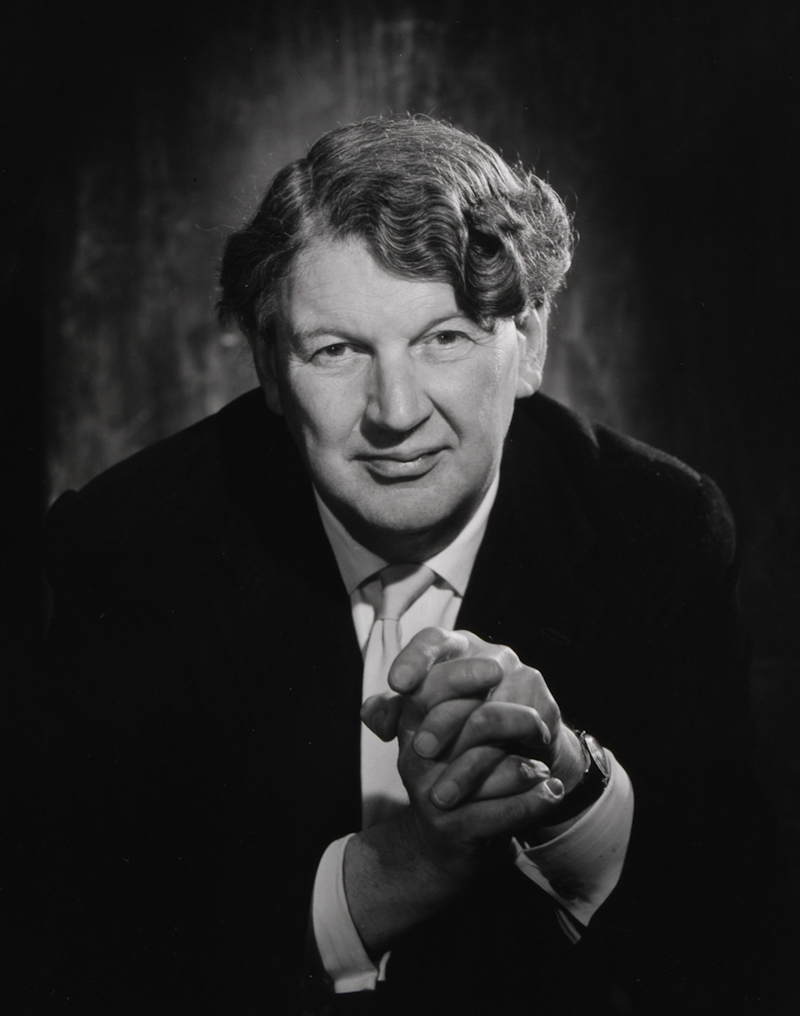 John Zachary Young FRS, c.1960s ©Godfrey Argent Studio (RS.21056)
John Zachary Young FRS, c.1960s ©Godfrey Argent Studio (RS.21056)
Alongside those mentioned above, many other Fellows of the Royal Society made contributions. Working from the Stazione Zoologica in Naples and in Plymouth, John Zachary Young FRS (1907-1997) introduced the squid giant axon to neurophysiology in the mid-1930s. At the Marine Biological Laboratory (MBL) in Woods Hole, MA, Kenneth Stewart Cole ForMemRS (1900-1984) and George Marmont co-developed the ‘voltage clamp’ with Hodgkin, Huxley, and Katz in the late 1940s. Utilising electronic feedback, voltage clamps could maintain the voltage across the squid giant axon membrane at set values, enabling studies of what happened in the fibre under each condition. In the 1960s and 1970s, working (often with Katz) at the Stazione, Ricardo Miledi FRS (1927-2017) employed squid giant axons to help unravel the integral roles of calcium ions in chemical signalling.
Squid giant axon studies had global reach, and in Sea Change I emphasize the myriad people and laboratories involved, including women, organism collectors, and scientists outside the US and Europe. In part two of this article, I’ll be looking at further sources in the archives of the Royal Society.


